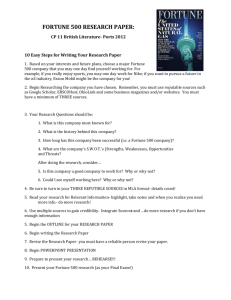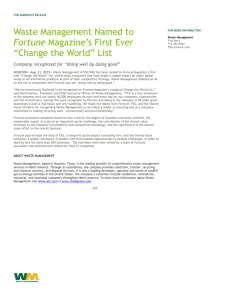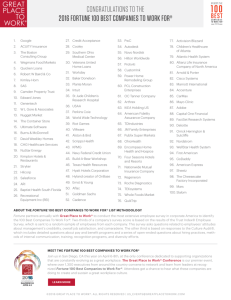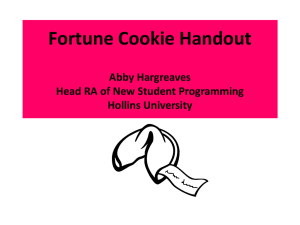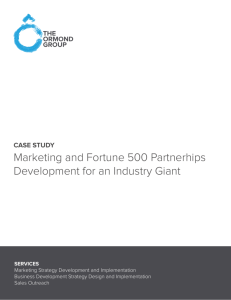The point of view most often showcased in Fortune
advertisement
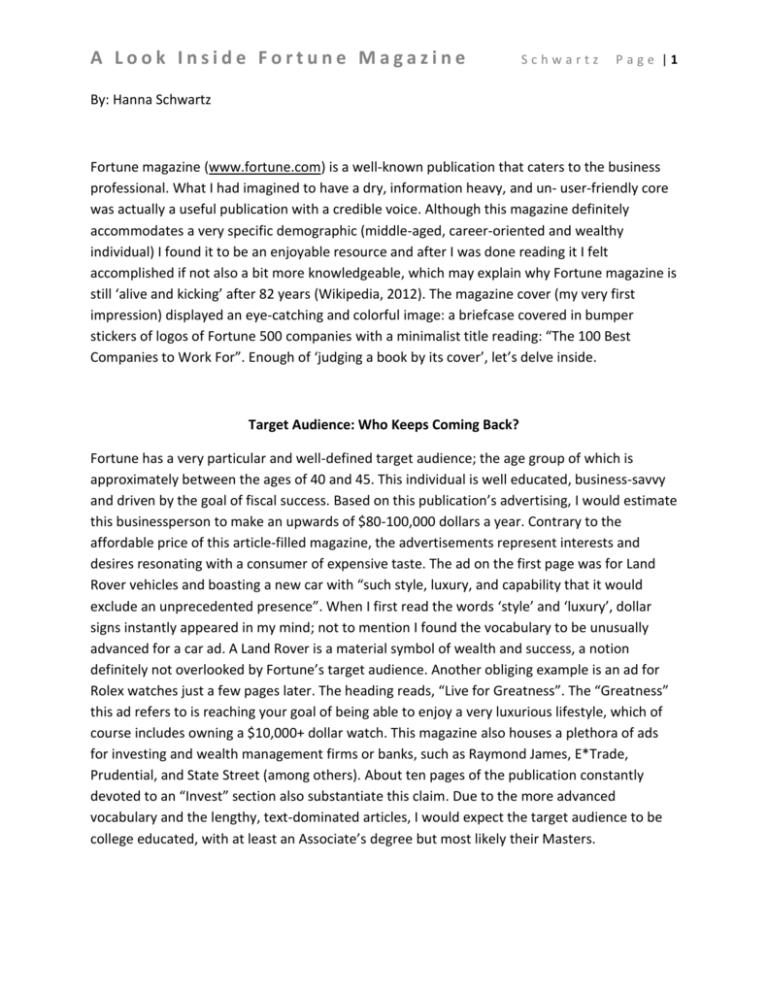
A Look Inside Fortune Magazine Schwartz Page |1 By: Hanna Schwartz Fortune magazine (www.fortune.com) is a well-known publication that caters to the business professional. What I had imagined to have a dry, information heavy, and un- user-friendly core was actually a useful publication with a credible voice. Although this magazine definitely accommodates a very specific demographic (middle-aged, career-oriented and wealthy individual) I found it to be an enjoyable resource and after I was done reading it I felt accomplished if not also a bit more knowledgeable, which may explain why Fortune magazine is still ‘alive and kicking’ after 82 years (Wikipedia, 2012). The magazine cover (my very first impression) displayed an eye-catching and colorful image: a briefcase covered in bumper stickers of logos of Fortune 500 companies with a minimalist title reading: “The 100 Best Companies to Work For”. Enough of ‘judging a book by its cover’, let’s delve inside. Target Audience: Who Keeps Coming Back? Fortune has a very particular and well-defined target audience; the age group of which is approximately between the ages of 40 and 45. This individual is well educated, business-savvy and driven by the goal of fiscal success. Based on this publication’s advertising, I would estimate this businessperson to make an upwards of $80-100,000 dollars a year. Contrary to the affordable price of this article-filled magazine, the advertisements represent interests and desires resonating with a consumer of expensive taste. The ad on the first page was for Land Rover vehicles and boasting a new car with “such style, luxury, and capability that it would exclude an unprecedented presence”. When I first read the words ‘style’ and ‘luxury’, dollar signs instantly appeared in my mind; not to mention I found the vocabulary to be unusually advanced for a car ad. A Land Rover is a material symbol of wealth and success, a notion definitely not overlooked by Fortune’s target audience. Another obliging example is an ad for Rolex watches just a few pages later. The heading reads, “Live for Greatness”. The “Greatness” this ad refers to is reaching your goal of being able to enjoy a very luxurious lifestyle, which of course includes owning a $10,000+ dollar watch. This magazine also houses a plethora of ads for investing and wealth management firms or banks, such as Raymond James, E*Trade, Prudential, and State Street (among others). About ten pages of the publication constantly devoted to an “Invest” section also substantiate this claim. Due to the more advanced vocabulary and the lengthy, text-dominated articles, I would expect the target audience to be college educated, with at least an Associate’s degree but most likely their Masters. A Look Inside Fortune Magazine Schwartz Page |2 Point of View: An Informed Perspective The point of view most often showcased in Fortune magazine is from an experienced and knowledgeable perspective. The articles are mostly factual, sometimes sporting a bit of narrative, and commonly reference interviews, photographs, and graphic statistics for support. I found this to be a relatively objective standpoint. An article I thought from the title to be politically- motivated and biased was actually focused on a company called Wayin, an online polling business. When the article is subjectively written, it is because the author is an established and inspiring business success, such as Reid Hoffman, the founder of LinkedIn and investor in powerhouses such as Zynga and Facebook whose book excerpt is published in Fortune’s most recent issue. Structure: A Formula for Success Kudos to Fortune for having a very readable, organized, and easily navigate-able layout. I never understood how something could be both minimalistic and intricate at the same time, but Fortune’s structure does just this. The table of contents is simple and displays bold-faced page numbers of the main features included in this issue in a vertical format. All of the supporting statistics, throughout the magazine, are boldfaced and in easily noticed, bright colors (note Figure 1) and the main points are often numbered to differentiate messages. All similarly styled articles are grouped together, such as Opinion, Invest, and Innovation topics. The style varies depending on the subject but can be anything from long opinion pieces to polls, lists, and quizzes. Pie charts, statistics, and bullets are utilized throughout main articles. Interviews follow a question (bolded font) and answer format and the last page of this month’s issue offers an interactive quiz Figure 1-http://mrmagazine.wordpress.com/2010/03/04/the-mrwith self-scoring. The cover story (“100 Best magazine%E2%84%A2-interview-with-andy-serwer-managingeditor-fortune-magazine-a-fortune-rooted-in-the-past-spreads-itsCompanies to Work For”) lists the companies’ wings-to-the-future/ ranking, location, employee count and fun facts, with a key that distinguishes symbols that stand for characteristics, such as if the company is currently hiring, their perks, and so on. A Look Inside Fortune Magazine Schwartz Page |3 Credibility: Why I have no doubts When you look up “credible publications” in the dictionary, Fortune would be the definition… not really but you get the idea. Fortune is an extremely credible publication. Two of the main stories (The Secrets Apple Keeps, and The Real Way to Build A Network) are beyond reliable due to the fact that, concerning their credibility, they literally wrote the book on that subject (with most of the article being their book excerpts). In addition, Fortune articles include an overflow of statistics and quotes, both of which re-enforce credibility. Also, credibility in some cases is due to a successful combination of education and experience, especially in Bob Rodriguez’s case, who is the managing partner and CEO of First Pacific Advisors, a $17 billion dollar investing firm). A neat tool that Fortune uses is that they basically list the subject’s accomplishments, confirming that they are indeed an authentically knowledgeable resource. For example, on the sideline of Rodriguez’s interview, credentials are listed: age, job experience, and his “claim to fame”. This publication’s reputation (as an inspiring, informative resource) also plays a huge role in its credible integrity. A Powerful Voice The vocabulary would seem complicated to an un-educated public but to my target audience, described above, it is perfectly appropriate. Because this audience is information seeking and well educated the sophistication instilled here is much needed and appreciated. The tone is informative yet not condescending and although the subject matter is not simple, it is displayed simply enough. The language used is lively yet professional with a touch of humor (commonly displayed in play on words) and approaches the seemingly dull topic of investing with an innovative, fresh, and interesting voice. Fortune’s Style: Impressive, But Not My Cup of Tea Fortune’s formal writing style differs profusely from my own modern and creative writing approach. I respect and appreciate Fortune’s perspective and in the category of informative, business-centered writing, Fortune magazine earns five stars. I am not in the career field of investing and therefore would be highly under qualified to write for a publication when most of their contributors carry such a high caliber of business expertise. I would prefer to write for a less serious and more exploratory publication such as www.opensalon.com with more of a blog feel. A Look Inside Fortune Magazine Schwartz Page |4 My former connotation of Fortune magazine as boring has been replaced with prestigious and a secure feeling that these writers really know what they are talking about! I genuinely enjoyed the financial advice and economic insight while browsing through the aweing photographs and well-written articles; not to mention I walked away after reading it with a few fun facts to use as intelligent conversation starters. Word count: 1,222 A Look Inside Fortune Magazine Schwartz Page |5 Works Cited Wikipedia. (2012, January 28). Fortune (magazine). Retrieved Febuary 8, 2012, from Wikipedia: http://en.wikipedia.org/wiki/Fortune_%28magazine%29
